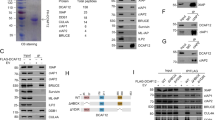Abstract
X-linked inhibitor-of-apoptosis protein (XIAP) interacts with caspase-9 and inhibits its activity1,2,3, whereas Smac (also known as DIABLO) relieves this inhibition through interaction with XIAP4,5,6,7. Here we show that XIAP associates with the active caspase-9–Apaf-1 holoenzyme complex through binding to the amino terminus of the linker peptide on the small subunit of caspase-9, which becomes exposed after proteolytic processing of procaspase-9 at Asp 315. Supporting this observation, point mutations that abrogate the proteolytic processing but not the catalytic activity of caspase-9, or deletion of the linker peptide, prevented caspase-9 association with XIAP and its concomitant inhibition. We note that the N-terminal four residues of caspase-9 linker peptide share significant homology with the N-terminal tetra-peptide in mature Smac and in the Drosophila proteins Hid/Grim/Reaper8,9, defining a conserved class of IAP-binding motifs. Consistent with this finding, binding of the caspase-9 linker peptide and Smac to the BIR3 domain of XIAP is mutually exclusive, suggesting that Smac potentiates caspase-9 activity by disrupting the interaction of the linker peptide of caspase-9 with BIR3. Our studies reveal a mechanism in which binding to the BIR3 domain by two conserved peptides, one from Smac and the other one from caspase-9, has opposing effects on caspase activity and apoptosis.
This is a preview of subscription content, access via your institution
Access options
Subscribe to this journal
Receive 51 print issues and online access
$199.00 per year
only $3.90 per issue
Buy this article
- Purchase on Springer Link
- Instant access to full article PDF
Prices may be subject to local taxes which are calculated during checkout





Similar content being viewed by others
References
Deveraux, Q. L. et al. Cleavage of human inhibitor of apoptosis protein XIAP results in fragments with distinct specificities for caspases. EMBO J. 18, 5242–5251 (1999).
Sun, C. et al. NMR structure and mutagenesis of the third BIR domain of the inhibitor of apoptosis protein XIAP. J. Biol. Chem. 275, 33777–33781 (2000).
Datta, R. et al. XIAP regulates DNA damage-induced apoptosis downstream of caspase-9 cleavage. J. Biol. Chem. 275, 31733–31738 (2000).
Verhagen, A. M. et al. Identification of DIABLO, a mammalian protein that promotes apoptosis by binding to and antagonizing IAP proteins. Cell 102, 43–53 (2000).
Du, C., Fang, M., Li, Y., Li, L. & Wang, X. Smac, a mitochondrial protein that promotes cytochrome c–dependent caspase activation by eliminating IAP inhibition. Cell 102, 33–42 (2000).
Srinivasula, S. M. et al. Molecular determinants of the caspase-promoting activity of Smac/DIABLO and its role in the death receptor pathway. J. Biol. Chem. 275, 36152–36157 (2000).
Chai, J. et al. Structural and biochemical basis of apoptotic activation by Smac/DIABLO. Nature 406, 855–862 (2000).
Abrams, J. M. An emerging blueprint for apoptosis in Drosophila. Trends Cell. Biol. 9, 435–440 (1999).
Chen, P., Nordstrom, W., Gish, B. & Abrams, J. M. Grim, a novel cell death gene in Drosophila. Genes Dev. 10, 1773–1782 (1996).
Srinivasula, S. M., Ahmad, M., Fernandes-Alnemri, T. & Alnemri, E. S. Autoactivation of procaspase-9 by Apaf-1-mediated oligomerization. Mol. Cell 1, 949–957 (1998).
Liu, Z. et al. Structural basis for binding of Smac/DIABLO to the XIAP BIR3 domain. Nature 408, 1004–1008 (2000).
Rodriguez, J. & Lazebnik, Y. Caspase-9 and APAF-1 form an active holoenzyme. Genes Dev. 13, 3179–3184 (1999).
Wu, G. et al. Structural basis of IAP recognition by Smac/DIABLO. Nature 408, 1008–1012 (2000).
Saleh, A., Srinivasula, S. M., Acharya, S., Fishel, R. & Alnemri, E. S. Cytochrome c and dATP-mediated oligomerization of Apaf-1 is a prerequisite for procaspase-9 activation. J. Biol. Chem. 274, 17941–17945 (1999).
Acknowledgements
We thank R. Penn for help with calculating IC50 values. This work was supported by the NIH (E.S.A, P.D.R, Y.S.). S.M.S. is a special fellow of the Leukemia and Lymphoma Society; Y.S. is a Searle scholar and a Rita Allen scholar.
Author information
Authors and Affiliations
Corresponding author
Rights and permissions
About this article
Cite this article
Srinivasula, S., Hegde, R., Saleh, A. et al. A conserved XIAP-interaction motif in caspase-9 and Smac/DIABLO regulates caspase activity and apoptosis. Nature 410, 112–116 (2001). https://doi.org/10.1038/35065125
Received:
Accepted:
Issue Date:
DOI: https://doi.org/10.1038/35065125
This article is cited by
-
Molecular basis for nuclear accumulation and targeting of the inhibitor of apoptosis BIRC2
Nature Structural & Molecular Biology (2023)
-
A Review on Caspases: Key Regulators of Biological Activities and Apoptosis
Molecular Neurobiology (2023)
-
Potential anticancer properties and mechanisms of thymoquinone in osteosarcoma and bone metastasis
Cellular & Molecular Biology Letters (2022)
-
Inhibition of noncaspase proteases, calpain and proteasome, via ALLN and Bortezomib contributes to cell death through low degradation of pro-/anti-apoptotic proteins and apoptosis induction
Medical Oncology (2022)
-
Necroptosis, pyroptosis and apoptosis: an intricate game of cell death
Cellular & Molecular Immunology (2021)
Comments
By submitting a comment you agree to abide by our Terms and Community Guidelines. If you find something abusive or that does not comply with our terms or guidelines please flag it as inappropriate.



